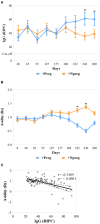Parasitemia and Associated Immune Response in Pregnant and Non-Pregnant Beef Cows Naturally Infected With Neospora caninum
- PMID: 35774976
- PMCID: PMC9238358
- DOI: 10.3389/fvets.2022.905271
Parasitemia and Associated Immune Response in Pregnant and Non-Pregnant Beef Cows Naturally Infected With Neospora caninum
Abstract
The aim of this longitudinal study was to characterize the parasitemia of Neospora caninum and the associated immunological parameters in naturally infected beef cows for 10 months. The following groups were established: Neospora caninum seropositive pregnant cows (+Preg, n = 7), seropositive non-pregnant cows (+Npreg, n = 7), seronegative pregnant cows (-Preg, n = 4), and seronegative non-pregnant cows (-Npreg, n = 4). Several samples were obtained for absolute and relative leukocyte counting, cytokines IL-10, IL-12, α-TNF, and γ-IFN quantification, specific IgG, IgG1, and IgG2 and avidity and N. caninum DNA molecular detection and quantification. The +Preg group had a higher frequency and concentration of N. caninum DNA in PBMC in the last third of pregnancy compared to +Npreg (p <0.05), with 22 and 8% of detection, respectively. Parasitemia correlated positively with IgG titers and negatively with IgG1/IgG2 ratio (p <0.05). On day 222 of the assay, the +Preg group had the lowest total leukocyte counting (p <0.05). The +Preg group had a higher concentration of IgG and higher avidity in the last third of gestation compared to +Npreg (p <0.05). Avidity correlated with total IgG and IgG2 (p <0.05). All +Preg cows gave birth to clinically healthy but seropositive calves before colostrum intake, therefore, the congenital transmission was 100% efficient. Only a complete N. caninum genotype from a placenta and a partial genotype from cow #3 of the group +Preg were achieved by multilocus microsatellite analysis. Overall, N. caninum parasitemia is frequent in seropositive beef cows during the last third of gestation. This correlates with higher antibody levels and a decrease in total leukocyte counting. The precise timing of the parasitemia may be used for diagnosis purposes and/or for design strategies to avoid vertical transmission. Further studies are needed to identify the immune molecular mechanisms that favor parasitemia during gestation in chronically infected cattle.
Keywords: Neospora caninum; cattle; immune response; parasitemia; pathophysiology.
Copyright © 2022 Gual, Campero, Hecker, Regidor-Cerrillo, Leunda, Odeón, Campero, Torioni de Echaide, Echaide, Estein, Ortega-Mora and Moore.
Conflict of interest statement
The authors declare that the research was conducted in the absence of any commercial or financial relationships that could be construed as a potential conflict of interest.
Figures





Similar articles
-
Anti-Neospora caninum antibody detection and vertical transmission rate in pregnant zebu beef cows (Bos indicus): Neospora caninum in pregnant beef cows (Bos indicus).Comp Immunol Microbiol Infect Dis. 2014 Sep;37(4):267-70. doi: 10.1016/j.cimid.2014.08.002. Epub 2014 Aug 23. Comp Immunol Microbiol Infect Dis. 2014. PMID: 25193073
-
Frequency of Neospora caninum infections in beef cow-calf operations under extensive management.Vet Parasitol. 2016 Mar 30;219:40-3. doi: 10.1016/j.vetpar.2016.02.002. Epub 2016 Feb 3. Vet Parasitol. 2016. PMID: 26921037
-
Innate and humoral immune parameters at delivery in colostrum and calves from heifers experimentally infected with Neospora caninum.Mol Immunol. 2021 Apr;132:53-59. doi: 10.1016/j.molimm.2021.01.016. Epub 2021 Feb 2. Mol Immunol. 2021. PMID: 33545625
-
Different humoral mechanisms against Neospora caninum infection in purebreed and crossbreed beef/dairy cattle pregnancies.Vet Parasitol. 2011 May 31;178(1-2):70-6. doi: 10.1016/j.vetpar.2010.12.018. Epub 2010 Dec 21. Vet Parasitol. 2011. PMID: 21216103
-
Specific anti-Neospora caninum IgG1 and IgG2 antibody responses during gestation in naturally infected cattle and their relationship with gamma interferon production.Vet Immunol Immunopathol. 2009 Jul 15;130(1-2):35-42. doi: 10.1016/j.vetimm.2009.01.003. Epub 2009 Jan 19. Vet Immunol Immunopathol. 2009. PMID: 19201036
References
-
- Dubey JP, Hemphill A, Calero-Bernal R, Schares G. Neosporosis in Animals. 1st ed: Boca Raton, FL: CRC Press (2017).
LinkOut - more resources
Full Text Sources

